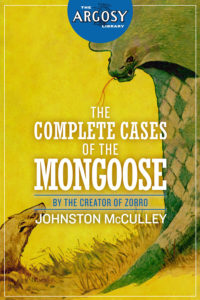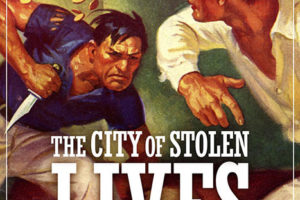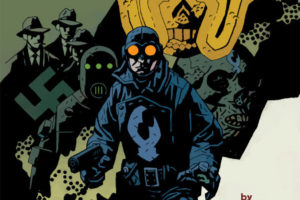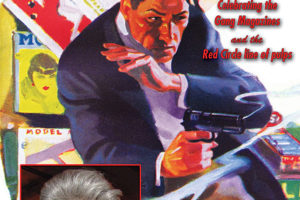 I have read many of Johnston McCulley‘s various pulp heroes and villains. There are only a few that I haven’t, and one I couldn’t because no one had reprinted him. Now that has been addressed by Steeger Books and its Argosy Library, which has published The Complete Cases of The Mongoose as one volume.
I have read many of Johnston McCulley‘s various pulp heroes and villains. There are only a few that I haven’t, and one I couldn’t because no one had reprinted him. Now that has been addressed by Steeger Books and its Argosy Library, which has published The Complete Cases of The Mongoose as one volume.
The Mongoose is another variation on the vengeance hero. His series ran over nine stories in Munsey’s Detective Fiction Weekly from March 26, 1932, to May 27, 1933. The first story was cover featured and that cover serves as the cover of the collection. We also get a great introduction by Peter Poplaski on McCulley, his career, and many of his serialized and masked characters.
Well, who is The Mongoose, and how does he fit in with McCulley’s other characters? One big change was that this one ran in a Munsey magazine, when almost all his prior characters appeared in Street & Smith’s Detective Story Magazine.
McCulley had been doing some stories in other pulps, but this was the first major series at another pulp publisher.
From the intro, this series was originally planned at DSM, but something went wrong, and he reworked it for DFW. He would shortly stop appearing at DSM, due to a change in editors, though I don’t believe that was the cause of the switch.
Having read several of McCulley’s characters, I see the repeat of themes or tropes, in different variations. You’ll see this with The Mongoose as some elements come back but in different form, some elements don’t appear, and new ones appear.
As noted, The Mongoose is a vengeance hero. He is going after the crooks who drove his father to death. But a big difference here is he’s joined by his sister, who works with him. While strong female characters are rare in the pulps, there is some precedence for this, including in McCulley’s works. The Man in Purple was assisted by his girlfriend. And closer is the mysterious girl who helped The Avenging Twins, who acted similarly to The Gray Seal‘s Tocsin.
A variation is that McCulley has used twin brothers (The Avenging Twins), twin sisters (Alias Madame Madcap), but this may be the first time he’s used a brother/sister team. And both are involved in the story. With no costume or hood (expect for once in the last story), the two use disguises to hide their identities and get close to their targets. A change is that they aren’t suspected in their real identity. While there is danger they will be caught in the act, once they are out of their disguises, the danger is gone. There is no cop after The Mongoose who they tweak or who suspects them.
Also different from most vengeance heroes, it’s not clear how many targets The Mongoose will need to go after, and the series ended after nine stories without a clear resolution. The Avenging Twins, The Thunderbolt, and even Mr. Death had six people they were going after, while The Rollicking Rogue didn’t have a clear number of bad guys.
It’s a bit unsatisfying that the story didn’t get a clear ending. I wonder why the series ended without this resolution? Was it not popular enough?
And I found it interesting how many similarities between The Mongoose and The Rogue I saw. Both were going after crooked financiers who framed their fathers, both of whom died in prison. Both heroes had planned for years, to the point of working their way into their first target’s life under an alias. Both had to contend with a private detective in the employ of the crooks rather than a cop. A cop, Tim Ladman, appears in the first Mongoose story and a few others, but is not a consistent character.
In the first story, we get the full backstory on The Mongoose. He is really Sidney Carleigh. His father, William Cratch, a meek bookkeeper, was framed by a group of crooked financiers, aided by a private detective. Sent to prison, he dies there, and his wife dies of a broken heart. Sidney has been planning for 10 years, helped by a large inheritance so he is independently wealthy. Disguised as meek private secretary Guthrie Jayne, he strikes against his boss Stephen Wazer, who is one of the crooks, during a meeting of a group of seven that include two other of the crooked group. Also on hand soon is the corrupt detective, Mark Graddon. So in the first story, we know of five specific targets, but also that there are more. Interestingly, Sidney reveals to the crooks that The Mongoose is Cratch’s son, and drops his disguise as Guthrie, which he had used for a year. But doesn’t reveal he is aided by his sister, Eleanor. And there is no way to connect Sidney Carleigh and his sister to the son of Cratch.
We also see that The Mongoose has other skills. He is a master of disguise, aided by the fact he is hairless due to a fever as a youth. He has a knowledge of chemistry and electronics. He makes dicta-phone cylinders that dissolve into nothing after exposure to air (like the Mission: Impossible self-destructing tapes), smoke bombs, knockout drugs in water, cigars, and others. He also has listening devices and hidden speakers, and more. His sister is also a master of disguise as well.
In the first three stories they go after the trio of crooked financiers introduced in the first story. In the fourth story, they go after the lawyer who had defended their father, but who was paid off by the crooks and didn’t really help their father. In the next two stories, they go after two who gave false testimony against their father. The first witness was interesting, being a fake Indian mystic. From him they steal the jewels of a rajah who would take his revenge against the mystic. In the seventh story, they go against another crooked financier who is on the edge of ruin, taking his emergency fund of gold coins. Then we have someone who was put on the jury to swing them to voting guilty. The final story had another connected to the case, but it wasn’t clear what part he played.
In each story, how they get close to their targets is different as is what they steal. But as there is no connection between their activities and their real life, there is not any tension in the story once they have dropped their disguises and return to their real identities, unlike in prior series.
It’s unfortunate that this series arc wasn’t concluded. They were going to go after the judge, they were saving the detective toward the end, and in the first story had the evidence to clear their father and were saving that for the finale, which we never got. I wonder if McCulley had even outlined the series in any way? But it’s a fascinating character (or characters), nonetheless. It’s also educational to see how McCulley does another variant on these characters.



